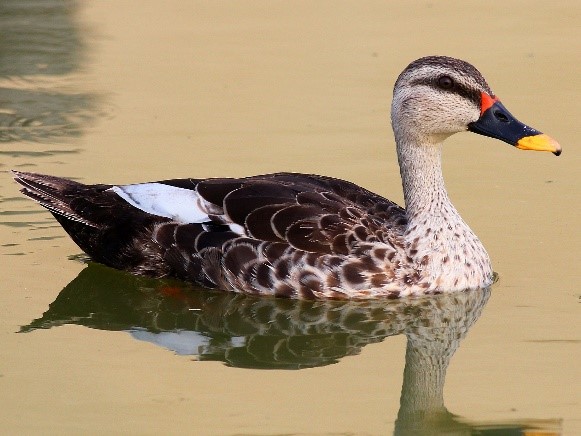INDIAN SPOT-BILLED DUCK

Disclaimer: Copyright infringement not intended.
Context
- An Indian spot-billed duck (Anas poecilorhyncha) with pale plumage was sighted at Manickapuram tank in Tiruppur district recently.
Indian Spot-Billed Duck
About
- The Indian spot-billed duck (Anas poecilorhyncha) is a species of large dabbling duck that is a non-migratory breeding duck throughout freshwater wetlands in the Indian subcontinent.
- When in water it can be recognized from a long distance by the white tertials that form a stripe on the side, and in flight it is distinguished by the green speculum with a broad white band at the base.
- This duck is a resident throughout Pakistan and India in freshwater wetlands.
- They tend to avoid very large patches of open water and prefer medium-sized wetlands with vegetation cover.
- It is a bird of freshwater lakes and marshes in a fairly open country and feeds by dabbling for plant food mainly in the evening or at night.
Description
- The male spot-billed ducks are larger than the females, measuring 60 to 65 cm in length and weighing 1,200 to 1,500 grams.
- The females weigh 800 to 1,350 grams. Their wingspan is 80 to 90 cm.
- It has a scaly patterned body with a green speculum and a band of white tertials. The body is brown-grey.
- The females are browner with duller patterns. The dark bill is tipped yellow.
- The male duck has an orange-red patch at the base of the bill.
Habitat
- These spot-billed duck species inhabit both inland and coastal wetlands such as ponds, lakes, pools, streams, creeks, estuaries, tidal flats, and marshes.
Feeding habits
- They mostly feed on grasses and other vegetation. Sometimes they may feed on insects.
Breeding
- The breeding season varies according to the local rainy season.
- The birds in Northern India breed during July to October and those in South India breed during November and December.
- The nest is built near water and is concealed in vegetation. Eight to twelve eggs may be seen in the nest.
Distribution
- The subspecies p. poecilorhyncha is distributed in the Indian Subcontinent, including Pakistan, Nepal and Bangladesh. The subspecies A. p. haringtoni is distributed in Assam State in India, Myanmar, China and Vietnam.
Movement Patterns
- These spot-billed duck species are mostly sedentary and they may migrate locally for water sources and feeding grounds.
Status and Conservation
- This duck population is large and is widespread. The combined population of both the subspecies is estimated to be 150,000-1,100,000 individuals. There is pressure of hunting, habitat degradation, and hybridization with other closely related species.
- The IUCN (International Union for Conservation of Nature) has categorized and evaluated these spot-billed duck species and has listed them as of "Least Concern".
|
PRACTICE QUESTION Q. Consider the following statements. 1.The Indian spot-billed duck is a migratory breeding duck throughout freshwater wetlands in the Indian subcontinent. 2.The IUCN has categorized and evaluated these spot-billed duck species and has listed them as Vulnerable. 3.This duck is a resident throughout Pakistan and India in freshwater wetlands. 4.Spot-billed duck species inhabit both inland and coastal wetlands. How many of the above are correct? A) Only 1 B) Only 2 C) Only 3 D) All Four Answer: B) Only 2 |




.jpg)
1.png)
